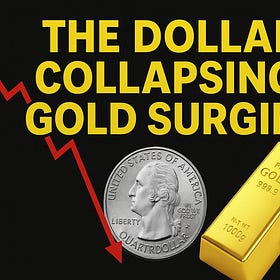In a wide-ranging interview on the Commodity Culture podcast hosted by Jesse Day, veteran trader and technical analyst Francis Hunt outlines a stark vision for the global economy. Drawing on over 30 years of experience and the principles behind his Hunt Volatility Funnel method, Hunt articulates what he sees as the final unraveling of the current monetary system—a period he calls “The Great Collapse.” In his forecast, traditional financial safe havens will be left in tatters while gold surges to unimaginable heights.
This article explores Hunt’s thesis in depth, with a breakdown of each major theme, direct quotes from the conversation, and contextual analysis to help readers understand the significance and implications of his warnings.
The U.S.-China Trade War: A Symptom of Broader Decline
“No, you don’t win it. The US does not win that war.”
With this blunt statement, Francis Hunt begins his assessment of the burgeoning trade conflict between the U.S. and China, sparked by tariffs and political tensions. He paints a vivid metaphor of the U.S. as a once-mighty bodybuilder—*"a hard-partying bodybuilder that's taken steroids and got late in years… now in the pub at 55, a bit drunk, liver in poor shape"—*desperate to reclaim respect and fearful of diminishing power.
Rather than viewing the trade war as an isolated political strategy, Hunt sees it as the external symptom of internal decay.
“It is a controlled demolition. It was always the intention to take bad stuff, get toxic, be a big tough man for a while, and then you burn your wick out.”
Hunt suggests that the U.S. has exhausted its dominance by abusing its privileged monetary position—borrowing excessively, exporting inflation, and leaning on military and financial leverage. The trade war with China is not a contest of strength but an act of desperation in a broader systemic decline.
Broken Foundations: Debt, Bonds, and the End of Rate Cuts
“This is not 1987 where Greenspan can cut the rates and reflate. It’s not 2000. It’s not 2008. And it’s not 2020.”
Each of these past crises was resolved through interest rate cuts or massive quantitative easing. But today, Hunt says, the bond market has turned against the U.S., and the appetite for treasuries is evaporating.
“Nobody wants it as a reserve asset… The USD comes with a US. It’s borrowed into existence. Gold doesn’t have a pair—it has no associated liability.”
He adds that home loan originations are declining and that there's “$9 trillion in rollovers that simply can’t be ignored.” Coupled with unfunded liabilities—like Social Security and Medicare—which he estimates could total “$600 trillion,” the financial system is facing an existential reckoning.
According to Hunt, the foundational mechanics of fiat-based capitalism are failing. With debt levels spiraling, interest payments rising, and bond buyers vanishing, the government no longer has the means to reflate the economy. This is a central premise of the coming reset.
Deeper Dive: The Carry Trade Unwind and USD/JPY Dynamics
“They borrowed in yen… bought dollars, pushing the dollar up and suppressing the yen… but now the treasuries collapsed in value, and the dollar’s going down.”
Hunt explains the carry trade as a hidden yet explosive risk. Institutions have borrowed in yen for years due to low interest rates and invested in U.S. treasuries and equities. As Japan normalizes rates, this margin disappears, and positions must be liquidated.
“The unwind doesn’t just mean bond sales—it’s selling the dollar, selling treasuries, and it's highly deflationary.”
He also hints that large banks caught in the middle may trigger contagion, especially if Japan continues its rate hikes.
The carry trade was a major source of global liquidity. Its reversal signals a collapse in demand for U.S. assets, rising yields, and renewed market stress. Hunt sees this as a crucial domino in the chain reaction leading to the Great Collapse.
Dollar DOOMSDAY? Inside the Shocking Prediction That's Rocking Global Markets
The concept of the dollar as the global reserve currency has underpinned US economic power for decades. This status allowed the US to exert significant influence over international trade and finance. Kenny's assertion that this system is "breaking" is a bold one. The rise of alternative economic blocs like BRICS and their efforts to establish independent financial systems pose a direct challenge to dollar dominance.
Anatomy of a Broken Banking System: Europe’s Hidden Fault Lines
“You have state-backed zombie banks… still holding bad paper from 2008.”
Hunt points out that European banks like Deutsche Bank, Commerzbank, and the now-absorbed Credit Suisse never truly cleaned up their balance sheets. Specific issues include legacy exposure to subprime debt, synthetic derivatives, and constrained balance sheet capacity due to regulatory pressures.
“They’re not allowed to fail, but they’re not allowed to function freely either.”
The ECB's monetary policy masked the decay by suppressing yields. But rising inflation and borrowing needs now force the hand. Hunt warns that the introduction of the digital euro is preparation for a dual system where the old one is allowed to collapse. These banks remain structurally impaired, incapable of handling rising interest costs or new systemic shocks.
Gold: The Last Man Standing
“Gold is without doubt the best thing you can have right now.”
Hunt sees gold as the primary beneficiary of the reset. Institutional investors, sovereign banks, and elites are turning to it as fiat and bonds lose credibility.
He also makes a controversial call:
“The gold-silver ratio could extend right the way into the 170s… maybe even 200.”
When pressed, Hunt speculates that gold could reach between $8,500 and $10,000 per ounce, depending on how far the gold-silver ratio stretches and the magnitude of the equity collapse.
While many anticipate silver outperformance, Hunt urges patience. He sees a phased rotation: gold first, silver later. His strategy involves increasing silver exposure only once the gold-silver ratio drops below 75. Gold, in his view, is not only the safest store of value but potentially the highest-performing asset of the decade.
Dow-Gold Ratio: The Chart That Predicts Collapse
“You go short the Dow, long gold—you get your multiple of 24x or more.”
Hunt uses the Dow/Gold ratio as a macro indicator of economic reset phases. Historical precedents include:
This chart is Hunt’s north star. He anticipates gold outperforming stocks by 24x to 48x as fiat systems implode. He views this as the final unwinding of a century-long monetary experiment.
CBDCs and Digital Compliance Systems: Hunt’s Dystopian Framework
“CBDCs will be programmable. You'll only get UBI if you meet criteria—vaccine status, carbon footprint, political views.”
Hunt believes the post-collapse system will use Central Bank Digital Currencies to enforce compliance. He describes a future where money is not earned or saved but granted through behavior-based algorithms.
He envisions:
Spending restrictions: money expires or becomes unusable outside your assigned region.
Social score integration: based on health status, political opinions, or consumption behavior.
Surveillance finance: every transaction is recorded and evaluated for conformity.
“It’s not money—it’s a control mechanism.”
Hunt’s dystopian forecast aligns with growing global interest in programmable money. His thesis: gold is freedom. It’s the only store of value that remains beyond government reach.
Conclusion: A Cycle Ends, A Reset Begins
Francis Hunt does not predict a recession—he predicts a global systemic reset. In his view, everything from debt markets and fiat currency to geopolitical alliances and personal freedoms is on the cusp of radical transformation.
“You’ve never had a gold market like this. This is the end of the full cycle. This is the reset.”
Whether one agrees or not, Hunt’s insights offer a compelling framework for interpreting current financial and geopolitical developments. His call to action? Get informed, get prepared, and get gold.













